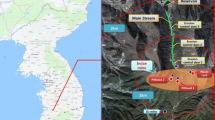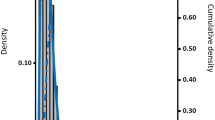Abstract
The short term human exposure studies conducted on populations exposed to high concentrations of inorganic arsenic in soil have been inconsistent in demonstrating a relationship between environmental concentrations and exposure measures. In Australia there are many areas with very high arsenic concentrations in residential soil most typically associated with gold mining activities in rural areas. This study aimed to investigate the relationship between environmental arsenic and urinary inorganic arsenic concentrations in a population living in a gold mining area (soil arsenic concentrations between 9 and 9900 mg kg−1), and a control population with low arsenic levels in soil (between 1 and 80 mg kg−1). Risk factors for increased urinary arsenic concentrations were also explored. There was a weak but significant relationship between soil arsenic concentrations and inorganic urinary arsenic concentration with a Spearman correlation coefficient of 0.39. When participants with greater than 100 mg kg−1 arsenic in residential soil were selected, the coefficient increased to 0.64. The geometric mean urinary inorganic arsenic concentration for the exposed group was 1.64 µg L−1 (<detection limit −28.4 µg L−1) and for the control group was 1.18 µg L−1 (<detection limit −4.69 µg L−1). Participants with residential soil in excess of 1000 mg kg−1 recorded a geometric mean urinary inorganic arsenic concentration of 2.46 µg L−1. In a random effects linear regression model, soil arsenic concentration was the significant predictor of increased urinary arsenic concentrations. Season was shown to have a significant influence on urinary inorganic arsenic concentrations. Other factors such as age, gender and hours of contact with soil may also be important risk factors. These results show that high concentrations of arsenic in soil can make a contribution to urinary inorganic arsenic concentrations.
Similar content being viewed by others
References cited
Australian and New Zealand Environment Council and National Health and Medical Research Council (ANZECC/NH&MRC). 1992 Guidelines for the Assessment and Management of Contaminated Land, Canberra, Australia.
Australian Water Resources Council (AWRC). 1982 Australian Water Quality Criteria for Heavy Metals, Technical Paper 77. Canberra: Australian Government Publishing Service.
Bates MN, Smith AH, Hopenhayn-Rich C. 1992 Arsenic ingestion and internal cancers: a review. Am J Epidemiol 135(5), 462–476.
Chen C-J, Chen CW, Wu M-M, Kou T-L. 1992 Cancer potential in liver, lung, bladder and kidney due to ingested inorganic arsenic in drinking water. Brit J Cancer 66, 888–892.
De Blas J, Gonzalez V, Rodriquez SR, Mendez J. 1994 Determination and speciation of arsenic in human urine by ion-exchange chromatography/flow injection analysis with hydride generation/atomic absorption spectroscopy. J AOACInt 77(2), 441–445.
Department of Manufacturing and Industry Development (DMID).1991 Arsenic in the Environment. Stage 1. Anonymous Victoria, Department of Manufacturing and Industry Development.
Freeman GB, Johnson JD, Killinger JM, Liao SC, Davis AO, Ruby MV, Chaney RL, Lovre SC, Bergstrom PD. 1993 Bioavailability of arsenic in soil impacted by smelter activities following oral administration in rabbits. Fundament Appl Toxicol 21, 83–88.
Freeman GB, Schoof RA, Ruby MV, Davis AO, Dill JA, Liao SC, Lapin CA, Bergstrom PD. 1995 Bioavailability of arsenic in soil and house dust impacted by smelter activities following oral administration in cynomolgus monkeys. Fundament Appl Toxicol 28, 215–222.
Glass DC, Gray CN. 2001 Estimating mean exposures from censored data: exposure to benzene in Australian petroleum industry. Ann Occupat Hygiene 45(4), 275–282.
Groen K, Vaessen HA, Kleist JJ, de Boer JL, van Ooik T, Timmerman A, Vlug RF. 1994 Bioavailability of inorganic arsenic from bog ore-containing soil in the dog. Environ Health Persp 102(2), 182–184.
Hewitt DJ, Miller GC, Nye AC, Simmons HF. 1995 Investigation of arsenic exposure from soil at a superfund site. Environ Res 68, 73–81.
Hinwood AL, Jolley DJ, Sim MR. 1999 Cancer incidence and high environmental arsenic concentrations in rural populations: results of an ecological study. Int J Environ Health 9, 131–141.
Hwang YH, Bornschein RL, Grote J, Menrath W, Roda S. 1997 Urinary arsenic excretion as a biomarker of arsenic exposure in children. Arch Environ Health 52(2), 139–143.
Kalman DA, Hughes J, van Belle G, Burbacher T, Bolgiano D, Coble K, Karle Mottel N, Polissar L. 1990 The effect of variable environmental arsenic contamination on urinary concentrations of arsenic species. Environ Health Persp 89, 145–151.
Kavanagh P, Farago ME, Thornton I, Goessler W, Kuehnelt D, Schlagenhaufen C, Irgolic KJ. 1997 Urinary arsenic species in Devon and Cornwall residents, UK. A Pilot Study. Analyst 123, 27–29.
Liu S, Lu I-C, Koplin DW, Meeker WQ. 1997 Analysis of environmental data with censored observations. Environ Sci Technol 31, 3358–3362.
National Health and Medical Research Council and National Food Authority (NH&MRC & FDA). 1990 The 1990 Australian Market Basket Survey Canberra: Australian Government Publishing Service.
Polissar L, Lowry-Coble K, Kalman D, Hughes JP, van Belle G, Covert DS, Burbacher TM, Bolgiano D, Mottet NK. 1990 Pathways of human exposure to arsenic in a community surrounding a copper smelter. Environ Res 53, 29–47.
Smith AH, Hopenhayn-Rich C, Bates MN, Goeden HM, Hertz-Picciotto I, Duggan HM, Wood R, Kosnett MJ, Smith MT. 1992 Cancer risks from arsenic in drinking water. Environ Health Persp 97, 259–267.
Roberts SM, Weimar WR, Vinson WR, Munson JW, Bergeron RJ. 2002 Measurement of arsenic bioavailability in soil using a primate model. Toxicol Sci 76(2), 303–310.
SPSS Inc. 1997 Advanced Statistics 7.5. Chicago: SPSS Inc.
Standards Australia. 1987 Australian Standard AS#3502-1987 Urine determination of total arsenic – furnace atomic absorption spectrometric method. New South Wales: Standards Australia.
Turpeinen R, Virta M, Haggblom, MM. 2003 Analysis of arsenic bioavailability in contaminated soils. Environ Toxicol Chem 22(1), 1–6.
Wong O, Whorton MD, Foliart DE, Lowengart R. 1992 An ecologic study of skin cancer and environmental arsenic exposure. Int Arch Occupat Environ Health 64, 235–241.
Author information
Authors and Affiliations
Rights and permissions
About this article
Cite this article
Hinwood, A.L., Sim, M.R., Jolley, D. et al. Exposure to Inorganic Arsenic in Soil Increases Urinary Inorganic Arsenic Concentrations of Residents Living in Old Mining Areas. Environmental Geochemistry and Health 26, 27–36 (2004). https://doi.org/10.1023/B:EGAH.0000020897.15564.93
Issue Date:
DOI: https://doi.org/10.1023/B:EGAH.0000020897.15564.93




